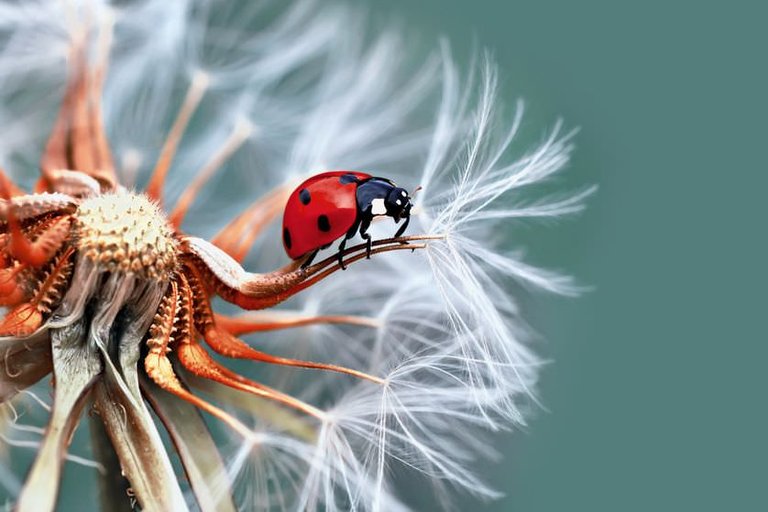
I do not know what about you, but I have a ladybug associated with childhood and with two memories. The first memory is related to cases when the insect landed on clothes, and we sang loudly a song to it, that was something like «Ladybug, fly to the sky, there your kids eat candy …» (a famous Russian children’s song). Surprisingly, the insect flew away, either because of a loud shouting, or our witchcraft worked. And the second memory is counting of points on the bug’s shell. For some reason, there was such a belief that the number of dots showed the age of a beetle.
I propose to look at this insect from the point of view of science.
HOW IS A LADYBUG RELATED TO GOD?
The official Latin name of the ladybird is not very memorable — Coccinellidae, in English it also sounds as ladybug and ladybeetle. True, «lady» means the Virgin Mary, that is, «the beetle of the Mother of God». If you look at the name of this beetle in other languages, you can see that they all point to some cattle that belongs to the superpower: the French call it «the chicken of the god», the Serbo-Croatians and the Germans — the sheep's lamb, the Romanians and Russians— the cow of the god.
It is not difficult to imagine that if this small creature is a «God’s» one, there might be cultures which forbid to kill them. And there are really some.
If to have a look into the past we find there a few versions of ladybird’s name. There is one legend according to which the god-thunderer had a wife. One day they quarreled, and he in a fit of anger turned her with the children into an insect: the children became dots on the red dress of a woman. And the other, historical version, says that in the Middle Ages during the invasion of aphids, farmers turned for help to the Virgin Mary to save the crop, after which new insects appeared on the fields (coincidence?!), which they called «ladybirds», meaning a bug from God’s Mother.
SPOTS ON THE SHELL
I, for example, remember that when I counted the spots on the backs of bugs, I often stopped at seven units. Of course, I was then surprised that almost all bugs were seven years old (according to my theory about their age). Now I have learned that the most common species of this insect is the seven-spot ladybird, and that the age of the insect has nothing to do with it. If you consider that the ladybirds live 2-3 years, then all my children's theory breaks down in one moment.

STAGES OF DEVELOPMENT
The seven-spot ladybird passes through several stages of development to become a recognizable insect. To be honest, I can not even believe that the middle stage of its growing is a black larva. But soon, in a couple of weeks, it turns into a creature with a bright coat color.

The pictures are from here.
One female lays about 300-400 eggs, but in years when there is plenty of food, the number of eggs laid reaches 1700! Ladybugs can be incredibly prolific.
These insects are unpretentious to the habitat, so they can easily adapt to different conditions. The only thing in winter is that they are looking for a warm place to wait out the cold. And such a warm place, oddly enough, may be someone's house.
In the world there are more than 5000 kinds of ladybirds. They are red, yellow, with clear points or unclearly outlined. Such a bright appearance is only to the benefit of these insects, because it discourages birds and animals. Moreover, if an insect senses a danger, then it emits yellow oily unpleasantly smelling liquid.

TINY, USEFUL ... PREDATOR
In addition to the fact that ladybugs look very nicely and defenselessly, they still play an incredibly important role in the natural cycle, and for humans in particular. It turns out that the vast majority of ladybirds are predators!
These insects eat other smaller creatures: aphids, whiteflies, spider mites. They have a rather big appetite, and for one day a ladybird can eat from 100 to 150 small insects. When the ladybug is in the larval stage, it feeds exclusively on aphids, destroying about 60 pieces per day.
Because of this natural gluttony, ladybirds are used as garden protectors against aphids. In history, there were cases when people deliberately inhabited citrus plantations with ladybirds to save them from the spread of the Australian chervets. This gives grounds to assume that it is possible that these insects will be bred in the future for agricultural purposes.
The nature is full of so many interesting things! Stay with me for more!
The pictures are under license CC0, unless indicated otherwise.
As a microbiologist, I've been reading/researching about just microorganism and ignoring beautiful creatures like this. Nature is indeed full of interesting things.
I agree)
Yes! Ladybugs are the most effective form of natural pesticides in an organic garden - they eat so many of the "bad" bugs! No sprays or chemicals needed!
Love that you're spreading this information :)
Thanks for reading!
Nature can be very deceiving, who would have thought the innocent looking ladybug is a predator??? wow!
:) That is so true!
Curious?
introduction post
Check out the great posts I already resteemed.Resteemed by @resteembot! Good Luck! The @resteembot's Get more from @resteembot with the #resteembotsentme initiative
Ladybugs are quite a nuisance in Nigeria but I still love the awesome creature of god anyway